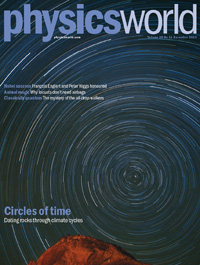By Matin Durrani

Well, despite all the excitement of last month’s special 25th-anniversary issue of Physics World, there’s been no let-up for us – we’ve been busy beavering away on the next issue of your favourite physics magazine, which is now ready for you to read in print, via our apps or online.
If you’re a member of the Institute of Physics (IOP), you can access the entire new issue free via the digital version of the magazine or by downloading the Physics World app onto your iPhone or iPad or Android device, available from the App Store and Google Play, respectively.
Our cover story this month is about a strange series of experiments, carried out by Yves Couder and Emmanuel Fort at Paris Diderot University, examining the behaviour of oil droplets vibrating on the surface of an oil bath. The droplets are classical in nature but also seem to show much of what would be expected of a quantum system, including interference patterns. So is this coincidence or not? Jon Cartwright investigates.
Elsewhere, we have an intriguing feature by Richard Corfield on how geological events can be dated through a chain of methods that link variations in the Earth’s orbit to the appearance and disappearance of glaciers and in turn to the quantity of radioactive nuclei in certain rocks.
Our final feature, by Katia Moskvitch, shows how the humble locust’s amazing collision-avoiding powers could possibly lead to better crash sensors for cars.
For the record, here’s a run-down of highlights in the issue.
• Englert and Higgs bag Nobel prize – Michael Banks reports on the awards of the 2013 Nobel Prize for Physics to François Englert and Peter Higgs, and examines the reaction from CERN.
• Korea targets leadership role in physics – The Republic of Korea has transformed itself over the last 50 years from a nation based primarily on agriculture to a hi-tech industrial powerhouse. But now the country is seeing the importance of investing in fundamental science too, as Matin Durrani reports.
• Deciding with science – From fracking and nuclear power to alternative medicine and
climate change, why is scientific input so often distorted or ignored where it is truly critical? Robert P Crease looks for some answers.
• A new spin on proceedings? – Heather Williams and Chris Packham argue that publishing conference proceedings as a multimedia-rich “iBook” could offer a new opportunity for meeting organizers.
• Classically quantum – They may look like simple oil drops, but they evoke many of the strange features of quantum mechanics. Jon Cartwright investigates whether this is a coincidence or not.
• Why locusts don’t need air bags – They are a farmer’s worst nightmare but, as Katia Moskvitch reports, locusts’ ability to avoid crashing into things makes them the stuff of dreams for an interdisciplinary group of robot designers.
• The echoes of eternity – Richard Corfield explains how our understanding of geological time has been revolutionized over the last decade by studying how cyclic variations in the Earth’s orbit are encoded into sediments and rocks.
• Politics or physics? – Gerard DeGroot reviews Churchill’s Bomb: a Hidden History of Science, War and Politics by Graham Farmelo.
• Letting the sunshine in – Alison Walker reviews Project Sunshine: How Science Can Use the Sun to Feed and Fuel the World by Tony Ryan and Steve McKevitt.
• From theory to market – Robert Jack describes how working for the materials-characterization firm Malvern Instruments satisfies both his scientific curiosity and his urge to produce something useful.
• Once a physicist – This month we talk to Robin Cruddace, a games developer at Games Workshop.
• Einstein’s performance appraisal – In this month’s Lateral Thoughts, Brian Petley looks at how Einstein might have suffered at the hands of today’s university administrators.
Enjoy the issue – and let me know what you think by e-mailing me at pwld@iop.org.
If you’re not yet a member, you can join the Institute as an IOPimember for just £15, €20 or $25 a year. Being an IOPimember gives you a full year’s access to Physics World both online and through the apps.
Your magazine viewing software does not seem to work on an ipad.
D
Hi Dan. The Physics World iPad app should display the magazine nicely on your iPad: https://itunes.apple.com/gb/app/physics-world/id418878994?mt=8